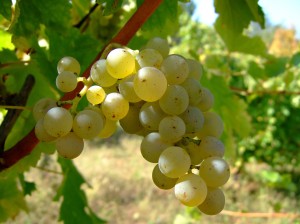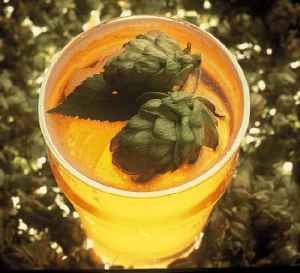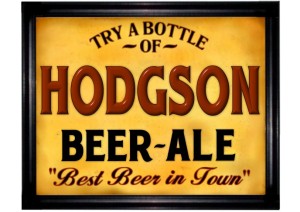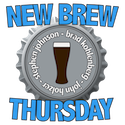Sauvignon Blanc = India Pale Ale
The marks my first “official” post in Project No Man’s Land. The project will consist of a series of posts illustrating linear pairings between wine varietals and beer styles. Naturally, this project is entirely subjective and has absolutely no scientific foundation. Nonetheless, I have a lot of confidence in its purpose and I am tremendously excited about starting this venture – regardless of the results.
Perhaps after this project I will no longer be known as The Beer Wench, but as The Beer & Wine Yenta … (matchmaker matchmaker, make me a match … find me a find … catch me a catch). But I digress, let us move on to the first pairing.
SAUVIGNON BLANC & INDIA PALE ALE
Now there is some method in my madness in picking this as the first pairing. First off, the Sauvignon Blanc varietal is nostalgic for me. When I was 16 years old, I went to France. (Quand j’avais seize anees, je suis allee au France.) My first winery tour and wine tasting experience was in the Loire Valley, France. And consequently, my first “real” sip of wine was a Sauvignon Blanc.

And this brings me to the India Pale Ale. Anyone who has ever interacted with me at some point, whether it be in real life or through the internet, knows that The Wench is an ale girl. Whereas I do experiment from time to time with different styles of lager, I prefer to stay where I am familiar - in the land of ales. It is only natural for me to begin my project with an ale . But not just any ale, folks. We are skipping the foreplay and diving right into the “king of hops” – the IPA. And you will see why, soon enough.
Now let’s get to the nitty gritty.
THE VARIETAL: Sauvignon Blanc

First, let us try to pronounce it: SOH-vihn-yohn BLAHN … SOH-vee-nyawn BLAHNGK. Good job.
The Sauvignon Blanc varietal first originated in the Bordeaux region of France, but it is now grown in just about every major wine making region in the world. Wines made from 100% Sauvignon Blanc are typically fermented in stainless steel and almost never touch oak. Because of this factor, it was one of the first fine wines to be bottled with a screwcap in commercial quantities.

Although its aroma and flavor profiles change with region and climate, the Sauvignon Blanc varietal is most commonly described as being dry, crisp, herbacious and acidic. Most Sauvignon Blancs are categorized as being either “herbaceous” (grassy) or “tropical” (citrusy). Other flavor and aroma descriptors include green & red peppers, flint, asparagus, gooseberry and even cat piss. These wines are typically light to medium in body, with moderate alcohol content.

Since it does not particularly benefit from aging, wine made from Sauvignon Blanc is usually consumed young. As with most things in life, though, there are “exceptions to the rule”. Oak-aged Sauvignon Blancs from the Pessac-Leognan and Graves regions in Bordeaux can be aged up to fifteen years.
Sauvignon Blancs pair very well with fresh seafood/shellfish/white fish/salmon (esp poached or lightly grilled), sushi, chevre (goat cheese), tart & herbacious cheeses, chicken (fried/roasted/sauteed), pork, curry, Thai food, Tex-mex food, salsa and vegetables (especially green and grilled).
THE STYLE: India Pale Ale

The origin of the IPA is greatly debated. But I am a story-teller by nature and, regardless of what the truth may be, the “creation myth” of the IPA is one of my favorite tales to tell.

Once upon a time, the crazy Brits decided that colonizing the country of India was an awesome idea. However, this was before planes, trains & automobiles. The fastest and most efficient way to get from England to India was to sail around the continent of Africa.

Obviously, this was not a short trip. Africa is a pretty damn big continent. Many consumable goods (including beer) could not survive the long voyage. In order to prevent the beer from spoiling during the trip, the traditional Pale Ale recipe needed to be tweaked. Beer already naturally contains 2 different preservation agents – hops & alcohol. Increase these elements and you get a recipe for success.

As legend goes, Hogdson was the most popular brewer during this time and has been credited as the creator of the original IPA. In order to ensure his ale weathered the journey to India, Hogdson made three crucial changes in his brewing methods. Hogdson increased the hopping rate, exaggerated the level of alcohol and used an abundant dry hopping process.

So I know what you are thinking – great story Wenchie, but what the heck does this have to do with the Sauvignon Blanc. And the answer is … absolutely nothing. I don’t even know if the story is accurate. I just like to tell stories.
Time to get down to business. In my opinion, Sauvignon Blanc’s beer equivalent is the IPA. Why? Both are medium-bodied, dry, crisp, herbacious and acidic. As with Sauvignon Blanc, the IPA style changes based on where it is produced. English IPAs are like Old World Sauvignon Blancs – softer and more balanced. American IPAs are like New Zealand Sauvignon Blancs – sharp and grassy with heavy notes of citrus.
Just as the Sauvignon Blanc varietal has exceptions, so does the IPA. There are a few interpretations of the IPA style with a higher malt content, which makes them similar to the oaked versions of the Sauvignon Blanc (I hope this makes sense). BUT – for the most part, the Sauvignon Blanc varietal and the India Pale Ale style are BOTH primarily known for dominant grass and citrus characteristics.

In addition to possesing very similar aroma and flavor profiles, India Pale Ales and Sauvignon Blancs pair well with many of the same foods. These include cheese, chicken, pork, salmon, seafood, curry, Thai food, Tex-Mex food, and salsa.
Since they can be sharp and astringent on the palate, both of these beverages tend be an “aquired taste”. I have an affinity for acidity, astringency and bitterness. As a result, the Sauvy B varietal and the IPA style happen to be two of my favorite beverages to drink. In my eyes, they possess similar qualities which make them almost interchangeable. I could easily drink an IPA under the same conditions as I would a Sauvignon Blanc. Hence my choice to make them a linear pairing.

And what do you think?
Is this a hit or miss?















Maggie Sudduth June 14th, 2009 at 12:54 pm
Wenchie, you are one funny writer – nice blog!
Drafternoon June 14th, 2009 at 1:22 pm
Good read
it is inspiring to discover where such great beers came from
IPA is prob. my favorite style
The Beer Wench June 14th, 2009 at 1:25 pm
Thanks girl!
edbstratt June 14th, 2009 at 3:14 pm
Just nothing like an IPA -love em’.
http://foodnmore.wordpress.com/
Randy Watson June 14th, 2009 at 4:18 pm
I really enjoyed reading this story! As someone who loves wine, I think its really cool to see how beer is not so different!
I look forward to reading more of your adventures into No Man’s Land!
Cheers!
Brew Hilda June 14th, 2009 at 9:24 pm
Could have used this information Saturday on the golf course- beer on the course, wine afterwards with dinner.
Now I can plan the entire menu for the next time. Thanks for the new knowledge. Enjoy the pictures, I’ve always loved picture books, why don’t you publish this stuff?!
THSeamonsters June 14th, 2009 at 9:44 pm
Discovered the Midas Touch at my local Whole Foods, tasting it a bit later on tonight, thanks for the lowdown! I liked the post, with the history of the two and comparison between the procedures to produce their tasting notes, and completely agree. I prefer the more citrus-heavy ones for that pizzazz while you drink, especially if it’s more sour or bitter, that really snaps your attention and reminds you you’re drinking something quite nice.
The Beer Wench June 15th, 2009 at 10:12 am
Hopefully, you will LOVE Midas Touch. It’s definitely not your average brew – but that is what makes it so special
Thanks for the great comments! I feel like you just patted me on the back – virtually.
The Beer Wench June 15th, 2009 at 10:12 am
Thanks … mom.
The Beer Wench June 15th, 2009 at 10:13 am
IPAs are amazing! Mmmm I’m such a hophead!
Jean-Marie Guffens April 22nd, 2010 at 8:02 pm
Again, not to beat a horse, but the similarity of aromatics and the palate presence/food interaction are completely different. Loire Sauvignon Blanc works with seafood and veg because of its high acid, non-obtrusive personality. IPA, by definition, is an aggressively aromatic bitter beer. The heaviest of barrel-fermented Graves lacks the palate-marring bitterness of IPA. Food-wise IPA is a turd in the punch bowl.